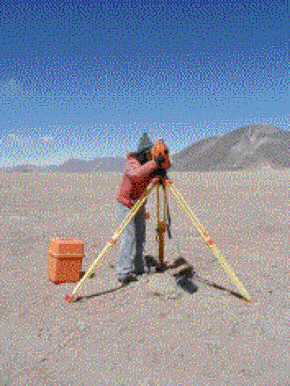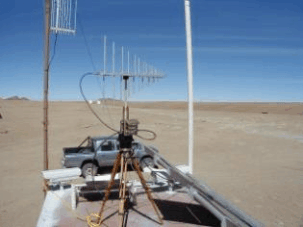
1.9 Science IPT
During January, the Science IPT Configuration Group delivered a revised ICD (version C) for the inner 172 antenna pads of the ALMA Configuration. This was considerably altered from the design approved by the JAO on 1 October but identical to that staked on the site during December and met a Level 2 Milestone for delivery of the inner configuration. Work continued on design of a long baseline part of the plan compatible with this new inner portion.
The primary activity of the Science IPT has continued to be production of the calibration plan for ALMA. A Level 3 Milestone for December 2002 produced a draft of calibration requirements document ready for reviews. This document updates Project Book Chapter 3.1 and is currently under review, to be finished at the end of February 2003 (Level 2 Milestone). The Calibration Group discussed new reports for one of the two amplitude calibration devices being considered for ALMA, the subreflector dual load device, being tested at BIMA. A plan for initial testing of the other device, incorporating a semi-transparent vane, was discussed at a face-to-face meeting of mostly European Science IPT members in Leiden, including plans for testing the prototype on the 30m telescope during the Spring of 2003.
The Site Characterization Group led a survey of radio frequency interference levels at Chajnantor.
The Science IPT arranged the agenda, minutes and telecon for the ASAC on 4 December and 8 January. Science IPT members from Europe gathered in Leiden 18-20 December; Butler represented the NA Science IPT members. A joint NA/EU Science Science IPT staff telecon was held 28 January, and four NA Science IPT telecons were held. A Calibration Group telecon 16 December was also held, preparatory to the Leiden meeting.
Anticipated activity in the next bimonthly period
Milestones Level 3 and above; some modifications made as a result of Leiden meeting.
Milestone |
Level |
Scheduled Completion |
I. B. 2. Configuration antenna motion logic |
3 |
31 March 2003 |
I. B. 3. Revise configuration |
3 |
31 March 2003 |
II. A. Calibration requirements Review |
2 |
28 February 2003 |
II. B. 1. Atmospheric modeling software available |
3 |
31 January 2003 |
II. B. 2. Draft specifications for calibration devices |
3 |
31 March 2003 |
II.D.1 Draft WVR technical aspects (with FE IPT) |
3 |
31 March 2003 |
III.A.1. Draft plan on attaining ACA goals |
3 |
31 March 2003 |
There is one Level 3 scheduled for completion in December 2002. A draft of the calibration requirements document has been produced for reviews. This is a modification of chapter 3 of the Project Book, complete with scientific examples for drivers. The Project Scientist issued a call to the ASAC during November to provide some examples for this exercise; they have been collected, discussed and disseminated. The issue of the calibration requirements document with science examples constitutes a Level 2 Milestone to be met 28 February 2003. A related Level 3 Milestone due in March 2003 will deliver draft specifications for calibration devices for reviews.
One Level 3 Milestone to be achieved in March will deliver to the project the ATM atmospheric modeling software being developed by Juan Ramon Pardo. This activity is in its final stages now; ATM has in fact been delivered to the European ADACE software project. This and other Level 3 and 4 Milestones lead toward the completion of the calibration strategy for ALMA, a Level 2 Milestone scheduled for September 2003.
In March 2003, a draft of the bandpass calibration plan will be presented, following publication and review of an ALMA Memo describing limitations of bandpass calibration using astronomical sources scheduled for February 2003. A presentation on this topic was given in Leiden and is available on ALMAEDM. Also in March, a draft of the phase calibration plan will be produced (Level 3). A further March milestone will be the production of the amplitude calibration plan, including total power calibration of ALMA. A further Level 3 milestone will review the SSR plan for all phase calibration techniques,
for completion in March. Other items scheduled for March include a draft of the antenna location determination plan, a draft of the delay calibration plan, a draft of global antenna pointing plans, reference pointing plans, focus calibration plans, and a draft of an operational model for calibration, including ideas on sequence of moves and calibrations, dynamic scheduling, and number of antennas needed in 'calibration subarrays' .
Leading to the September 2004 report on WVR strategies (Level 2), a March 2003 Level 3 Milestone presented a draft document on technical aspects of the WVR, along with the Front End IPT.
By March 2003, the Science IPT will prepare a draft plan on how to achieve ACA goals (flux-recovered imaging at all ALMA bands).
1.9.1 ASAC
The Science IPT facilitated the ASAC Telecons held on December 2002 and on 8 January 2003. It also supported discussions of the calibration examples, many contributed by ASAC members.
2.9.2 Configuration
New data on the terrain at Chajnantor spurred revision of the array configuration to better
conform to the landforms on the site; this was revision C. The specification document
ALMA-90.02.00.00-001-C-SPE gives the pad numbers and positions for the first
172 pads of baseline ALMA. The pads specified in this document will be used for
configurations of ALMA with maximum baselines out to 4.5km. An additional number
of

Figure 1 A surveyor locates the position for on of the 172 antenna stations to be built on the site, as specified by the configuration group of the Science IPT.
Pads will be needed for the larger (‘Y+’) configurations. The positions and numbering of these additional pads will be presented in a future specifications document or revision to this document.
Y+ Configuration
Two options are still under consideration for the Y+ configuration. The first option considers a series of semi-continuous moves (4 or 6 antennas at a time), with optimization of each step as a "stand-alone" configuration. The second option considered the largest Y+ configuration as being separately optimized, with the intermediate steps offering somewhat poorer performance.
The two approaches have been debated at the last ASAC, and further work by M. Holdaway has quantified the expected differences. The JAO considers that the operational constraints are likely to be significant, and thereby prefers the continuous approach.
However, simulations in which the largest configuration is complemented by short observations from the 4.5 km array (or a more compact one) may still be useful to define the optimal shape of the largest Y+ configuration.
Although the ALMA Compact Array proposed by Japan is not part of the baseline plan, the current site design provides (at no extra cost) two areas of 80x80 m located near the compact configurations which would suitable to host the ACA. The ACA could also be located further away from the centre of the ALMA compact array.
2.9.3 Calibration
Butler organized and moderated a ALMA Calibration Group phone telecon 16 Dec. Discussion focussed on planning for the Leiden meeting which followed after a few days. Action items included review of calibration examples, semi-transparent vane test plan, distribution of the ASAC Report and work on polarization requirements. Examples were presented by Guilloteau at the Leiden meeting, as was a report on the test plan (presentations were place on ALMAEDM for general access. Minutes were published both of this meeting, and of the Leiden meeting, for general information.
2.9.4 Site Characterization
Radford and Nyman proposed milestones for the site characterization group, which were discussed and merged into the Science IPT milestones.
A team from NRAO-Green Bank arrived at Chajnantor in December and carried out radio frequency interference tests for two weeks on the site. A report is in preparation. Specifications for emission from other projects to be located on the site (CBI, ASTE, APEX, and others) can be derived from this baseline survey.

Figure 2. Working with NRAO-Green Bank employees C. Beaudet and G. Watts, an initial radio frequency interference survey was made of Chajnantor during December 2002. This survey will enable specifications to be set for emission from other projects to be formulate.
1.8.5 Science Software Requirements
This group met face-to-face in Garching in December. Steve Myers and Jeff Mangum represented the Science IPT; much of the effort went to discussions of aips++.
1.8.6 Imaging
Activities centered on supporting definition of the ACA at IRAM. The ACA is under design in Japan.
2.9.7 Organization
The organization and planning for the Science IPT during the construction phase of ALMA was reviewed and discussed with EU Science IPT members during the face-to-face meeting in Leiden. Weekly telecons between the three project scientists continue, and there is a monthly telecon of the NA Science Team.
2.9.8 Meetings, Outreach and Public Education
Science IPT Meetings during December-January 2002-2003, along with topics discussed, included:
Agenda for 3 December 2002 News-- FE/BE Reviews, Total Power on ALMA--how to achieve it, Calibration discussion, New correlator proposal.
Agenda for 17 December 2002 News-- New Org Chart, Milestone list, Proposal for Cerro Negro Instrumentation, Configuration, Calibration Meeting, Science IPT Meeting.
Agenda for 31 December 2002 News-- Leiden Calibration Meeting Review
Agenda for 14 January 2003 News-- FIRST LIGHT on VertexRSI Antenna, Configuration matters, Milestone list, Calibration Meeting Presentations.
Science IPT Agenda for 28 January 2003 Discussion of Leiden meeting, science examples for calibration, configuration, correlator upgrade.
Calibration Group and ASAC Telecons were held as noted above.
Wootten represented ALMA at the NRAO booth at the American Astronomical Society meeting in Seattle Washington. At Caltech on other business, he discussed the state of ALMA informally with astronomers in the Caltech Submillimeter Observatory group, and with the OVRO group. Discussions included a meeting with postdocs and graduate students.
2.9.9 Concerns
There is concern whether the Level 2 milestone of "Review of tests of calibration strategies on prototype interferometer complete" can be met by December 2004. Although most elements of the prototype interferometer will be in place at the ATF by early 2004, the prototype receivers may not arrive until mid 2005 for testing later
that year. The Science IPT believes that this must be done earlier, if these calibration tests are to involve the actual ALMA receivers. Differences between the evaluation receiver interfaces and those of the prototype receiver suggest that substantial work would be required to implement the evaluation receivers for the prototype interferometer. The project should construct a plan for component verification at the prototype interferometer as soon as possible.